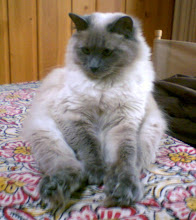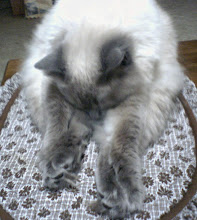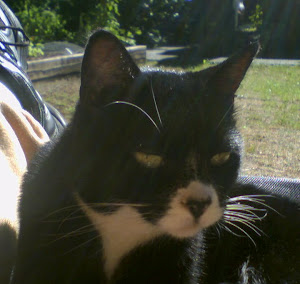Or a thousand and one ways to offend....Those blog-readers who occasionally glance at my side bar may notice that I appear to have been reading science fiction luminary Robert A. Heinlein’s
The Moon Is a Harsh Mistress for about two months. I have to admit I’ve been struggling with this book for a long time now, and not to be disrespectful to an acknowledged master in the SF genre or to his many devoted fans, I am inclined to bestow on it what noted SF writer and critic Thomas M. Disch might call a St. Bradbury.
The feast of St. Bradbury, Disch says, is when critics, readers, and reviewers gather up all the books they’ve been “unable, despite their best intentions and firmest resolves, to read all the way to the end,” and ceremoniously dispose of them. Disch puts it a bit more caustically, but like I said I don’t want to be disrespectful, since, despite what for me is a difficult roadblock on the Heinlein highway, I acknowledge there must be something good to account for Heinlein’s amassed critical and popular following.
So what’s my problem? Let’s just say that with
The Moon Is a Harsh Mistress, considered by most critics and many readers to be Heinlein’s finest, the gender issue once again raises its ugly head. Not half a dozen pages can pass in this avowedly political novel, without the male characters’ lengthy verbal and visual ogling of the female characters, and the female characters then simpering, giggling, and cooing their appreciation of the men’s appreciation. And this is generally DURING any of said political and philosophical conversations, although fortunately not so much during the action sequences, comprised so far in my reading of political rallies meeting with government reprisal, strongly flavored by the novel’s 1960’s origins.
All of this “he looked her up and down, and whistled”—followed by four or five paragraphs of extraneous flirtation—wouldn’t be so bad if Heinlein didn’t seem so bent on generalizing about what women think (and, believe me, Heinlein has NO problem writing with paranormal authority on what women think) and how women are different–which so far in my reading mostly seems to involve a propensity for intuition and girlish gossip, occasional short-lived and inexplicable (yet adorable) flirtatious huffs, and an abiding love of compliments.
Now, don’t mistake me, Heinlein may be a product of his times, but he is no misogynist. To quote Disch once again, Heinlein is more than eager to grant women “equal wages and equal fun” and a certain naïve amount of mental acuity. To cite another of Heinlein’s well-loved novels,
Stranger in a Strange Land presents a passel of female character, all of them nurses and secretaries, but at least he gives a few of them eidetic memories, plenty of smarts, and great job skills. Conveniently, as we are at length informed, they are also extremely attractive. But then, as Heinlein says in
Moon, there are no ugly women.
The Moon Is a Harsh Mistress is the story of political dissent and government rebellion at a former penal colony on the moon; it is also the story of a computer achieving consciousness. Is the computer “Mike” really a Michelle? Heinlein’s characters must, of course, dicker about this, since they have crystal clear ideas about gender differences, even when talking about banks of electronic controls. For myself, I will continue to struggle with both the book and its ideas, at least until the traditional date set for the feast of St. Bradbury, August 22 (“the great man’s birthday,” as Disch reminds us), or until someone or something pushes me to read past my roadblocks. I am hoping with an idealistic postmodern gusto that our hero and heroine will finally realize that Mike/Michelle’s identity changes depending on his/her audience and that that in itself is an indication of the social constructs of gender reflected in the novel and its characters. Then, at last, I will be able to pitch my tent in Heinlein’s camp.
I am not holding out strong hopes for this eventuality. Still, if there are any readers out there who have read
The Moon Is a Harsh Mistress and are up for debate, I am honestly open for discussion and ready to hear about the novel’s finer points, which I will then respectfully blog about to set the record straight. Push me to read a little faster. I am ready.
All quotes from Disch are from
On SF (University of Michigan Press, 2005). Quote from
The Moon Is a Harsh Mistress is from the Orb Edition (Tom Doherty Associates, 1997, copyright 1966), and appears on p. 71, among other pages.
Read more about Heinlein in the December 2007 Kitsap Sun:
Heinlein: The Descent of a Sci-Fi Guru
 Last week at the library we celebrated some of the exceptional literary works written about and during the 1930s, the era of America’s Great Depression. Our “Depression Era” theme day provided a great opportunity to promote the library and to talk about some of the books we love. Don’t believe me? While I was waiting for the bus, I struck up a lively conversation with two transit regulars who commented on my “migrant worker” overalls. They were enthralled with our theme: “You look just like the train boss in Of Mice and Men,” one commented, “You know, the one who kicks George and Lenny off the train.”
Last week at the library we celebrated some of the exceptional literary works written about and during the 1930s, the era of America’s Great Depression. Our “Depression Era” theme day provided a great opportunity to promote the library and to talk about some of the books we love. Don’t believe me? While I was waiting for the bus, I struck up a lively conversation with two transit regulars who commented on my “migrant worker” overalls. They were enthralled with our theme: “You look just like the train boss in Of Mice and Men,” one commented, “You know, the one who kicks George and Lenny off the train.” Steinbeck's 1939 novel The Grapes of Wrath—simply put—defines the era. To learn more about the history that shaped this moving novel and the research that went into it, read Steinbeck’s The Harvest Gypsies: On the Road to the Grapes of Wrath, comprised of seven newspaper articles Steinbeck published after touring migrant workers camps in 1936 and featuring Dorothea Lange’s stunning photographs of the era. For additional images, check out Restless Spirit: The Life and Work of Dorothea Lange. This beautifully-produced photo-biography presents a compilation of many of Lange’s most famous documentary-style portraits of America’s down-and-outs in the 1930s and 1940s, including her famous "Migrant Mother" that has since come to represent the face of 1930's dust-bowl poverty.
Steinbeck's 1939 novel The Grapes of Wrath—simply put—defines the era. To learn more about the history that shaped this moving novel and the research that went into it, read Steinbeck’s The Harvest Gypsies: On the Road to the Grapes of Wrath, comprised of seven newspaper articles Steinbeck published after touring migrant workers camps in 1936 and featuring Dorothea Lange’s stunning photographs of the era. For additional images, check out Restless Spirit: The Life and Work of Dorothea Lange. This beautifully-produced photo-biography presents a compilation of many of Lange’s most famous documentary-style portraits of America’s down-and-outs in the 1930s and 1940s, including her famous "Migrant Mother" that has since come to represent the face of 1930's dust-bowl poverty.












.jpg)





.jpg)




